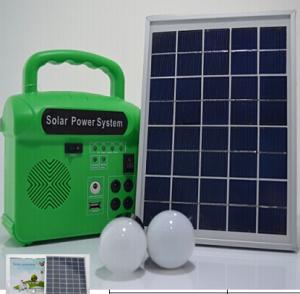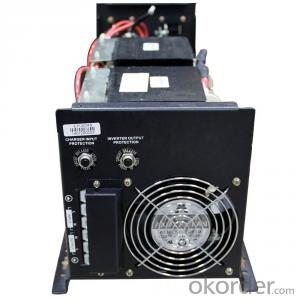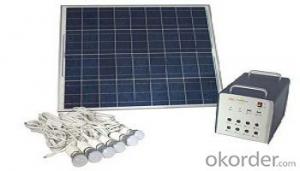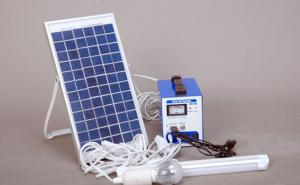Solar Energy Systems for Sale - CNBM Solar Home System Roof System Capacity-50w
- Loading Port:
- Shanghai
- Payment Terms:
- TT or LC
- Min Order Qty:
- 500 set
- Supply Capability:
- 10000 set/month
OKorder Service Pledge
OKorder Financial Service
You Might Also Like
Introduction of our company
We are the first solar racking system developer in China, who committed to solar racking system R&D, producing and marketing for about 10 years. We were the OEM for Sunpower, and are one of the largest rooftop solar racking system supplier in Japan and Australia now.
We are persisting the path of specialization, scale and internationalization development. We have been imported the international advanced technology equipment for manufacturing , assembling and testing. Frontier solar racking system is with own patents. The dynamic wind resistance reliability of our racking system can up to 270km/h. Therefore, superior product quality with more than 25 years' durability and perfect after-sale service have earned us a high reputation in PV industry worldwide.

Working Principle of Solar Roof System
The stand alone Solar Home System is an off-grid solar system which uses batteries to store the solar energy. Stand alone solar system solutions design for those who are not able or willing to connect to electricity grid.



Specification of Solar Home System

Product Features of Solar Home System
Off grid solar power system is mainly used for application with relatively-small power consumption, and the areas have no grid network coverage, or grid power is unstable or outage condition.
It’s composed of solar panels, hybrid solar inverter, battery bank, solar panel mounting racks, and other accessories required fora complete home solar power system.
The battery bank gives a stable power output to the solar inverter which converts DC to AC to power loads, and provides power backup in rainy or cloudy days.
The solar panels generate electricity at daytime and charge the battery bank.
The off grid home solar power system provides grid power bypass in case of battery power shortage when sunshine is not enough.
All the off grid home solar power system configurations are worked out by scientific calculation and design.
Advantage of Our Solar Home System
1. solar power system operation can automatically control and manual control modes.
2. Easy installation, energy saving (saving coal and petroleum resources, reduce pollution / noise emissions); do not need to lay long-distance transmission lines, do not build large substation, system stability, less maintenance, low maintenance cost, daily / each month / year electricity clearly visible, and can be entered into the computer record.
This solar system configuration is for reference. It can be adjusted based on actual condition and requirement. All parts have been tested and proven in actual operation with enough reliability and stability. It’s suggested to source whole system as a pack from us to guarantee the system compatibility.
Terms and Conditions
1. Trade terms: FOB Shanghai
2. Payment terms: 30% T/T, balanced before shipment/ LC at sight before shipment. Actual Terms can be negotiated for big order.
3. Package: Exported standard package suitable for tough handling and sea transport.
4. Delivery: Goods to be ready within 10~30 days depending on order quantity.
5. Warranty: 10 years for solar panel, 2 years for controller/inverter/battery.
FAQ
Q1. Can we design packaging?
Yes, but there is with quantity limitation. For 10,000 pcs, we will make the packing free for the client, and if less than 10,000 pcs, we can talk, the package is free or little money will be charged.
Q2. Can we add our logo on products?
Yes, there are several ways to do this. We can put the label of your logo on the products or make the silk print of your logo on the products. It is free.
Q3. can we customize product?
OEM and ODM are welcomed from Anern. We have rich experiences in this area.
Q4. What is your company return policy?
If we Anern breaks the contract of any agreement on price, quality and any other terms and conditions on the contract, the buyer can return the goods back to us and we will send the money back to buyers. Force majeure and god act are excepted.
Q5. What is your main product line is made?
LED street light and solar street lighting system, LED high bay light, LED flood light, LED tube light, bulb light, panel light, ceiling and down lights, all kinds of indoor lighting and outdoor lighting are available.
Q6.If I have a question I would like advice on how to contact you?
The best way is by e-mail. Tel, wechat, whatsapp, skype, contact us on our website online service worker are good ways to reach us also.
Q7. What will you provide services?
Solution providing, engineering, system design, best products suggestion, quality control, delivery, after sale service and many others. You can get our feedback during 24 hours.
- Q: Can a solar energy system be installed in a residential community with homeowners' association rules?
- Solar energy systems can indeed be installed in residential communities that have homeowners' association (HOA) rules. However, the regulations pertaining to solar panel installation can vary depending on the specific HOA. In certain cases, HOAs may impose restrictions on the type, size, or placement of solar panels. To proceed with the installation of a solar energy system in a residential community governed by HOA rules, homeowners would typically need to adhere to a set of guidelines or obtain approval from the HOA. This process may involve submitting an application, providing detailed plans and specifications of the system, and acquiring the necessary permits. Many HOAs have recognized the advantages of solar energy and have adopted supportive guidelines for solar panel installations. Some HOAs have even revised their rules to facilitate the installation of solar energy systems for homeowners. It is crucial for homeowners to carefully review the specific rules and guidelines of their HOA and establish communication with the association to fully comprehend the requirements and obtain the necessary approvals. In summary, while it is feasible to install a solar energy system in a residential community governed by HOA rules, it is vital to thoroughly examine the specific guidelines and secure approval from the HOA to ensure compliance and a seamless installation process.
- Q: How do solar energy systems affect the carbon footprint?
- Solar energy systems have a significant positive impact on reducing carbon footprint. By harnessing the sun's energy to generate electricity, solar systems eliminate the need for fossil fuels, which are major contributors to carbon dioxide emissions. This clean and renewable source of energy not only helps combat climate change but also reduces air pollution and dependency on non-renewable resources.
- Q: Can solar panels be installed on uneven or sloped surfaces?
- Yes, solar panels can be installed on uneven or sloped surfaces. However, the installation process may require additional components such as mounting brackets or frames to ensure the panels are securely attached and properly angled for optimal sunlight exposure.
- Q: Can solar energy systems be used in powering amusement parks?
- Yes, solar energy systems can be used to power amusement parks. Solar panels can be installed on the roofs of buildings, parking structures, or in open spaces within the park to generate electricity from the sun. This renewable energy source can help reduce the park's reliance on traditional grid power, lower operating costs, and decrease its carbon footprint. Additionally, solar energy systems can provide a reliable and consistent source of power, making them suitable for meeting the electrical demands of amusement parks.
- Q: How does the quality of solar panels vary based on the manufacturer?
- The quality of solar panels can vary significantly based on the manufacturer. Different manufacturers use different technologies, materials, and manufacturing processes, which directly impact the performance, reliability, and lifespan of the panels. Firstly, the efficiency of solar panels can vary based on the manufacturer. Efficiency refers to the ability of the panels to convert sunlight into electricity. Some manufacturers may use more advanced and efficient solar cell technologies, such as monocrystalline or thin-film, which can result in higher conversion rates compared to panels using polycrystalline cells. Secondly, the durability and reliability of solar panels are affected by the manufacturer. High-quality manufacturers conduct rigorous testing and use superior materials to ensure their panels can withstand harsh weather conditions, temperature variations, and impact from debris. They may also offer longer warranties, indicating their confidence in the product's durability. Thirdly, the lifespan of solar panels can vary based on the manufacturer's quality. Panels from reputable manufacturers are designed to have a longer operational life, typically ranging from 25 to 30 years. They may incorporate features such as anti-degradation technologies that prevent power output degradation over time. Furthermore, the manufacturing processes employed by different manufacturers can impact the overall quality of the panels. Manufacturers with strict quality control measures and standardized production practices tend to produce more reliable and consistent panels. They may also have certifications and comply with industry standards, ensuring their products meet or exceed set requirements. Lastly, customer service and support can also vary based on the manufacturer. Reputable manufacturers often provide excellent customer support, including after-sales services, technical assistance, and warranty coverage. This level of support can greatly impact the overall experience and satisfaction of solar panel owners. In conclusion, the quality of solar panels can differ significantly based on the manufacturer. It is important for consumers to research and choose panels from reputable manufacturers that offer higher efficiency, durability, lifespan, and customer support. Investing in high-quality solar panels ensures optimal performance and long-term savings in electricity costs.
- Q: Can solar energy systems be used for powering security cameras?
- Yes, solar energy systems can be used to power security cameras. Solar panels can be installed to capture sunlight and convert it into electricity, which can then be used to power security cameras and other surveillance equipment. This provides a sustainable and cost-effective solution for remote or off-grid locations where traditional power sources may be unavailable or expensive to connect. Additionally, solar-powered security cameras can operate independently and are not affected by power outages, making them a reliable option for continuous surveillance.
- Q: Can solar energy systems be used in powering street cameras or surveillance systems?
- Yes, solar energy systems can be used to power street cameras or surveillance systems. Solar energy is a sustainable and renewable source of power that can provide a reliable and independent energy supply for street cameras and surveillance systems. By installing solar panels on rooftops or mounting them on poles near the cameras, the panels can capture sunlight and convert it into electricity. This generated electricity can then be stored in batteries, which can be used to power the cameras and surveillance systems even during periods of low sunlight or at night. Using solar energy for street cameras and surveillance systems not only reduces the reliance on traditional power sources but also helps in reducing carbon emissions and minimizing the overall environmental impact. Additionally, solar-powered systems can be cost-effective in the long run as they eliminate the need for expensive cabling and provide a self-sustaining energy solution. Overall, solar energy systems are an excellent choice for powering street cameras and surveillance systems, offering numerous benefits such as sustainability, reliability, cost-efficiency, and environmental friendliness.
- Q: Can solar energy systems be used in areas with limited access to information technology?
- Yes, solar energy systems can be used in areas with limited access to information technology. Solar energy systems are independent and self-sufficient, requiring minimal technological infrastructure to operate effectively. They can provide a reliable and sustainable source of energy, even in remote areas with limited access to information technology.
- Q: Can a solar energy system be installed in areas with high seismic activity?
- Yes, a solar energy system can be installed in areas with high seismic activity. However, it is important to ensure that the system is designed and installed in a way that can withstand the potential impact of earthquakes. This may involve using specialized mounting systems, reinforcing structures, and conducting thorough assessments of the site's geological conditions. By following proper engineering practices and regulations, solar energy systems can be safely installed and operated in seismic-prone areas.
- Q: Can a solar energy system be installed on a commercial parking lot?
- Yes, a solar energy system can be installed on a commercial parking lot. Commercial parking lots often have ample space for solar panels to be installed on canopies or mounted on structures like carports. This allows for the generation of clean and renewable energy while also providing shade and protection for vehicles. Additionally, commercial parking lots are typically well-suited for solar installations due to their large surface areas and accessibility to sunlight.
Send your message to us
Solar Energy Systems for Sale - CNBM Solar Home System Roof System Capacity-50w
- Loading Port:
- Shanghai
- Payment Terms:
- TT or LC
- Min Order Qty:
- 500 set
- Supply Capability:
- 10000 set/month
OKorder Service Pledge
OKorder Financial Service
Similar products
Hot products
Hot Searches
Related keywords




























